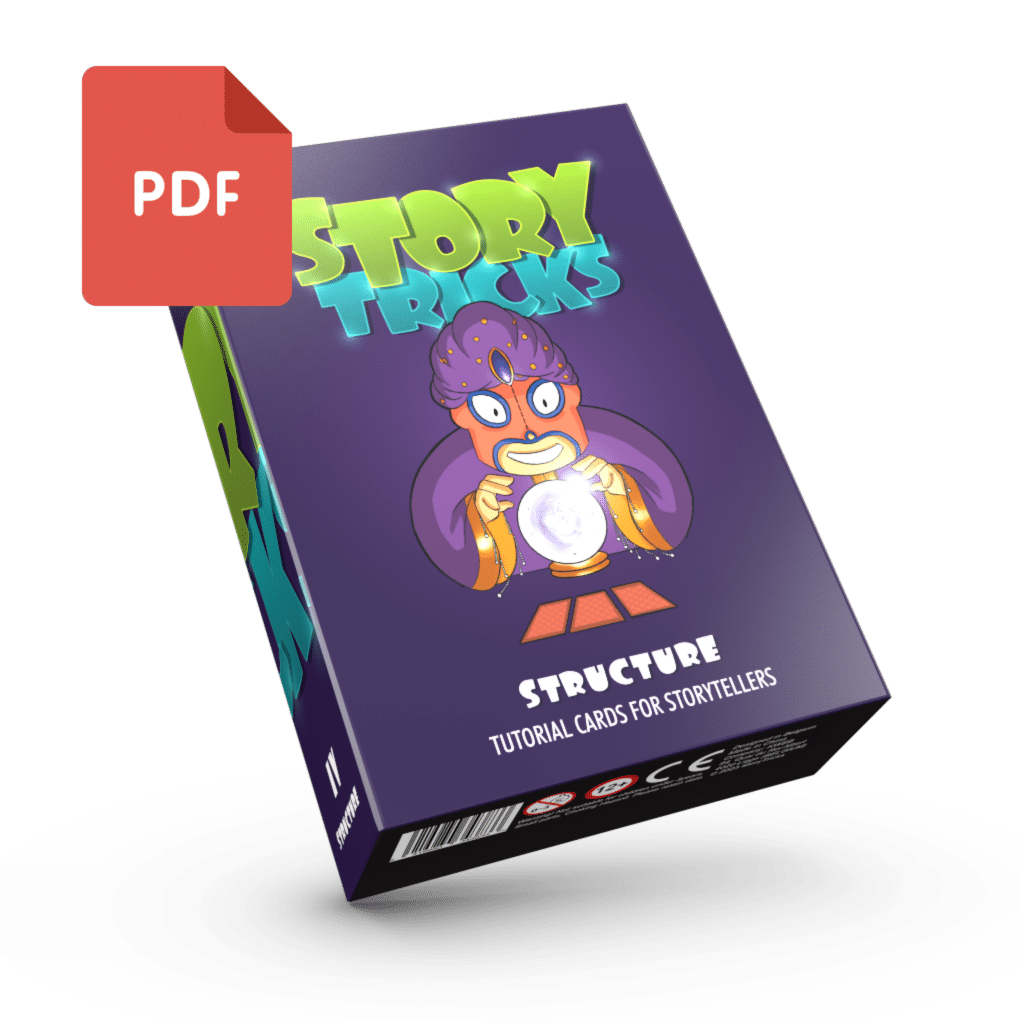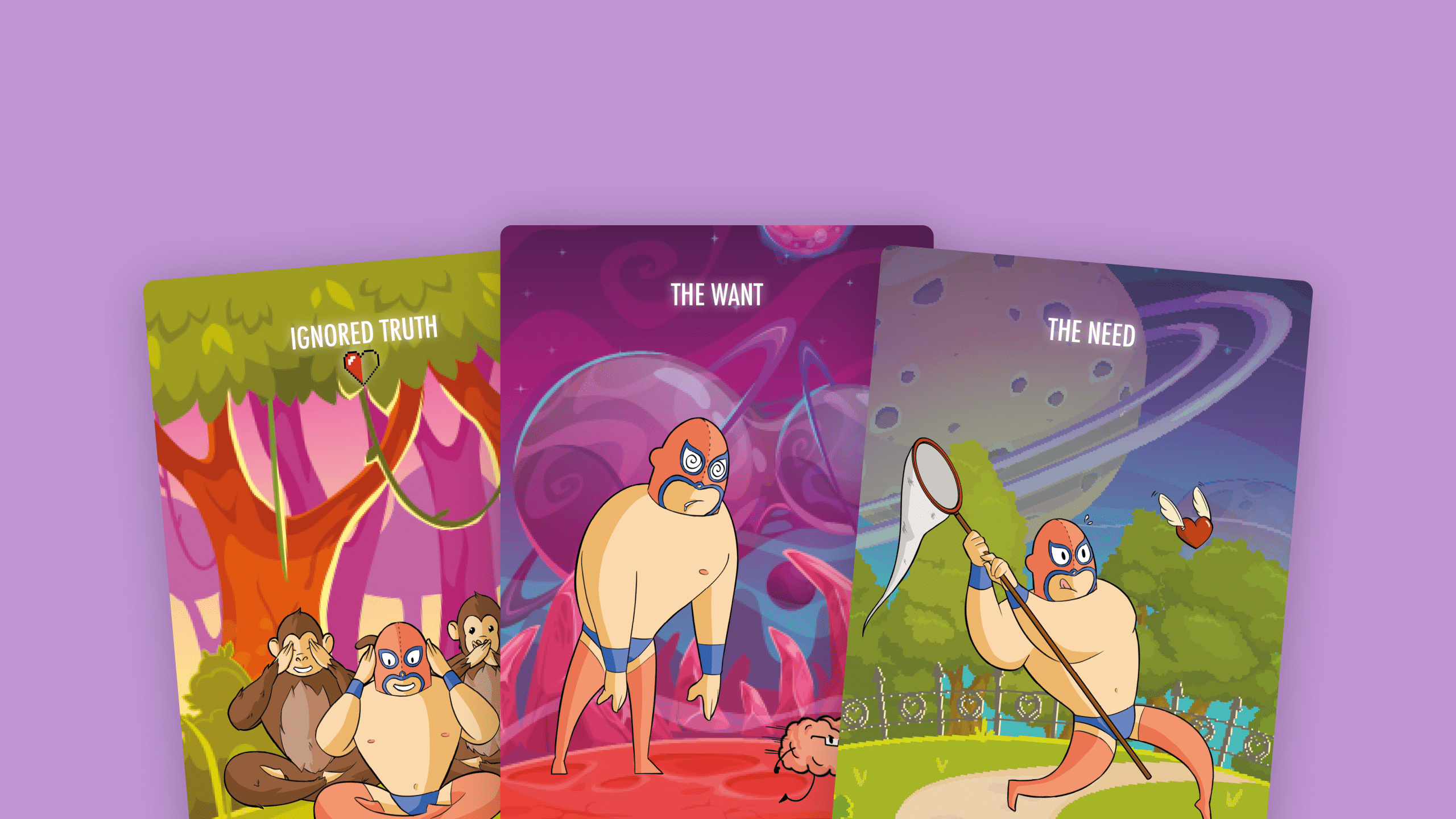Mastering story structure has been the secret sauce to captivate audiences for centuries. Whether you’re writing a novel, screenplay, or short story, the backbone of any compelling narrative is its structure. Without a solid structure, even the most fascinating characters and imaginative settings can fall flat. This is where the Structure Deck from StoryTricks comes in—a powerful tool designed to help writers master the art of story structure and craft narratives that resonate with readers.
Related Deck

Structure Deck
The ultimate road map to master story structure, plot points, and pacing.
Get my free deckIn this comprehensive guide, we’ll explore how the Structure Deck can help you master story structure, offering a simple yet powerful beat sheet that will guide you through the key elements of storytelling. We’ll dive into the following sections, each crucial for crafting a well-structured story:
Table of Contents
Understanding the MICE Quotient
The MICE Quotient, developed by science fiction author Orson Scott Card, is a framework that categorizes stories based on four elements: Milieu, Idea, Character, and Event. Understanding and applying the MICE Quotient (cards 500 to 505) is crucial for determining the primary focus of your story, which will, in turn, dictate its structure.
- Milieu: This focuses on the setting of the story—the world your characters inhabit. Stories driven by milieu often begin with a character entering a new environment and end when they leave it.
- Idea: Idea-driven stories revolve around the exploration of concepts or mysteries. The story begins with a question and ends when the question is answered.
- Character: In character-driven stories, the focus is on the transformation of a character. The narrative begins with the character in one state and concludes with them in a different state.
- Event: Event-driven stories are centered around significant occurrences that disrupt the status quo. The story starts when the event happens and ends when normalcy is restored (or a new normal is established).
By identifying which element of the MICE Quotient is most prominent in your story, you can better structure your narrative to keep the reader engaged. For example, a milieu-driven story might require detailed world-building and an exploration of the setting’s impact on the characters. In contrast, an event-driven story would prioritize pacing and the consequences of the central event.
The Normal World: Establishing the Status Quo
Every story begins with a Normal World—a state of equilibrium that sets the stage for the narrative’s conflict and progression. In the Structure Deck, cards 601 to 613 guide you through the process of establishing this world, which is essential for creating a strong foundation for your story.
The Normal World is where you introduce your characters, setting, and the existing social order. It’s the place where everything appears to be in balance, even if that balance is flawed or precarious. The key elements to consider when crafting your Normal World include:
- Introducing the Protagonist: Your protagonist’s everyday life is showcased here, along with their desires, fears, and motivations. This helps the audience understand who they are and what drives them.
- Setting the Stage: The world-building begins in earnest, whether you’re crafting a fictional universe or a slice of reality. The Normal World should feel tangible and lived-in, with details that hint at deeper complexities.
- Foreshadowing the Conflict: Subtle hints of the impending disruption are woven into the narrative. This could be an ominous sign, a minor disagreement, or an unresolved issue that will soon come to the forefront.
By meticulously constructing the Normal World, you create a stark contrast with the story’s later developments. This contrast heightens the impact of the inciting incident, which propels your protagonist out of the Normal World and into the adventure that lies ahead.
The Odd World: Journey into the Unknown
The transition from the Normal World to the Odd World (cards 614 to 619) marks the point where your story takes a turn into the unfamiliar. This shift is crucial for maintaining narrative momentum and keeping readers hooked. The Odd World is where the rules change, and your protagonist is forced to adapt or perish.
The Odd World often embodies the essence of the story’s central conflict. It could be a literal change in location, like a move from a small town to a sprawling city, or a metaphorical shift, such as a descent into madness or a plunge into the supernatural. Key considerations for the Odd World include:
- Disruption of the Status Quo: The protagonist is thrust into a situation that challenges their understanding of the world. This disruption is the catalyst for growth and change.
- New Rules and Challenges: The Odd World operates under different rules than the Normal World. These new rules create obstacles for the protagonist, forcing them to rethink their strategies and beliefs.
- Escalation of Conflict: As the protagonist navigates the Odd World, the stakes are raised. The challenges become more daunting, and the protagonist must confront their deepest fears and desires.
The Odd World is a place of transformation. It’s where your protagonist begins to shed their old self and inch closer to the person they need to become to resolve the story’s central conflict.
Midpoint: The Turning Point of Your Story
The Midpoint (cards 620 to 624) is the heart of your story—the moment where everything changes. This pivotal scene often represents a shift in the protagonist’s understanding of their situation, altering their goals and strategies.
At the Midpoint, the protagonist typically moves from a reactive to a proactive stance. This shift is crucial because it changes the direction of the story. The Midpoint can take several forms, such as:
- Revelation: A major discovery that changes the protagonist’s perspective on the conflict. This could be a hidden truth, a betrayal, or a sudden realization about their own capabilities or flaws.
- Decision: The protagonist makes a significant choice that sets the course for the rest of the story. This decision often carries high stakes and irreversible consequences.
- Confrontation: A confrontation with the antagonist or another powerful force. This clash heightens the tension and propels the story toward its climax.
The Midpoint is often where the protagonist’s character arc begins to crystallize. They may start to shed their initial misconceptions and embrace the reality of their situation, setting the stage for the final act of the story.
The Death: The Darkest Hour
Following the Midpoint, the story typically enters its darkest phase—the Death (cards 625 to 634). This section represents the protagonist’s lowest point, where all seems lost. The Death is not always literal, but it symbolizes a profound loss or failure that brings the protagonist to the brink of despair.
During this phase, the protagonist faces the consequences of their actions and decisions. This period of darkness is essential for several reasons:
- Testing the Protagonist: The protagonist is pushed to their limits, confronting their deepest fears and weaknesses. This test is crucial for their eventual transformation.
- Breaking Point: The protagonist may experience a moment of surrender or doubt, where they question their ability to succeed. This moment of vulnerability makes their eventual victory more meaningful.
- Loss: The Death often involves a significant loss, whether it’s a physical loss, like the death of a loved one, or an emotional one, like the shattering of a dream or belief.
The Death serves as the crucible in which the protagonist is forged into a new version of themselves. It’s the precursor to the Rebirth, where they will emerge stronger and more determined.
The Rebirth: Rising from the Ashes
After the darkness of the Death comes the Rebirth (cards 635 to 645), the final stage in the protagonist’s transformation. The Rebirth is the moment of triumph, where the protagonist rises from the ashes of their former self, armed with new knowledge, strength, and resolve.
The Rebirth is where the protagonist finally confronts the antagonist or resolves the central conflict of the story. Key elements of the Rebirth include:
- Renewed Purpose: The protagonist emerges from the Death with a clear sense of purpose. They now understand what they need to do to achieve their goal and are fully committed to seeing it through.
- Climactic Battle: The Rebirth often culminates in a final showdown between the protagonist and the antagonist. This battle is the ultimate test of everything the protagonist has learned and become.
- Resolution: The story concludes with the resolution of the central conflict. The protagonist has achieved their goal, and the world—whether the Normal World, the Odd World, or a new synthesis of the two—finds a new equilibrium.
The Rebirth is the payoff for all the tension and struggle that has come before. It’s the moment where the protagonist’s journey comes full circle, and they are forever changed by their experiences.
Conclusion: Harnessing the Power of the Structure Deck
The Structure Deck is more than just a tool—it’s a roadmap for mastering the art of storytelling. By following the guidance provided in each section of the deck, you can craft narratives that are not only structurally sound but also emotionally resonant.
The key to using the Structure Deck effectively is to understand that story structure is not a rigid formula but a flexible framework. It provides the scaffolding upon which you can build your unique story, allowing you to focus on creativity and character development while ensuring that your narrative remains cohesive and compelling.
Whether you’re a seasoned writer or just starting, the Structure Deck offers invaluable insights into the mechanics of storytelling. By mastering the elements outlined in this guide—from the MICE Quotient to the Rebirth—you’ll be well on your way to crafting stories that captivate and inspire.
So, grab your Structure Deck, start plotting your next story, and watch as your narrative unfolds with clarity, purpose, and power. The journey from the Normal World to the Rebirth is one of transformation, not just for your characters but for you as a storyteller. Happy writing!
Related Deck

Structure Deck
The ultimate road map to master story structure, plot points, and pacing.
Get my free deckUseful Links
Understanding the MICE Quotient
An in-depth explanation of the MICE Quotient framework and how it applies to storytelling.
https://www.tor.com/2018/01/17/the-mice-quotient-and-storytelling/
Orson Scott Card’s MICE Quotient
A detailed guide on how Orson Scott Card’s MICE Quotient can help structure your story.
https://www.writersdigest.com/write-better-fiction/the-m-i-c-e-quotient
The Hero’s Journey: The Normal World
An overview of the “Ordinary World” in the Hero’s Journey and its importance in storytelling.
https://mythcreants.com/blog/the-heros-journey-step-one-the-ordinary-world/
Worldbuilding Basics: Establishing Your Setting
Tips on how to create a compelling setting that serves as your story’s Normal World.
How to Create Conflict in Your Story
Techniques for introducing and escalating conflict in your story.
The Midpoint: A Key Turning Point
Understanding the Midpoint in storytelling and how it changes the direction of your narrative.
Story Structure: The Importance of the Midpoint
A closer look at the Midpoint and its role in effective story structure.
https://writersedit.com/fiction-writing/story-structure-importance-midpoint/
Dark Night of the Soul: The Death
An explanation of the “Dark Night of the Soul,” often referred to as “The Death,” and how it functions in a story.
Insights on crafting a powerful climax during the Rebirth phase of your story.
https://www.scribophile.com/academy/how-to-write-a-great-climax-in-a-story
Tips on how to structure the Rebirth and resolution of your story effectively.
https://www.savannahgilbo.com/blog/story-structure-resolution
